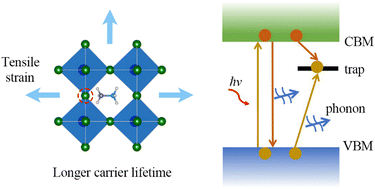Beneficial effects of tensile strain on charge carrier lifetime in metal halide perovskites containing halogen vacancies†
Abstract
We report a time-domain ab initio investigation of the tensile strain-dependent nonradiative charge recombination in methylammonium lead halide (MAPbI3) perovskites containing halogen vacancy defects. Our results show that applying tensile strain increases the Pb–Pb distance across the vacancy site and weakens the hybridization of Pb-p dangling states, leading to an upshift of the defect level. Shallower defect levels are beneficial to the suppression of trap-assisted electron–hole (e–h) recombination. Interestingly, strained systems exhibit a smaller dynamical disorder owing to the decreased vibrational anharmonicity, leading to weakened electron–vibrational interaction. Moreover, the bandgap increases with tensile strain because the valence band shows more anti-bonding character than the conduction band. Hence, direct e–h recombination bypassing the trap state is alleviated. The synergistic effects of tensile strain on e–h recombination, through and bypassing the trap state, prolong the charge carrier lifetimes by an order of magnitude under moderate strain. Our time-domain atomistic investigation highlights the importance of vibrational anharmonicity in charge carrier lifetime and provides fundamental insights into the passivation mechanism of halogen vacancies by tensile strain, which are of fundamental interest for further optimization of perovskite solar cells and other related devices.

- This article is part of the themed collection: 2023 Journal of Materials Chemistry C HOT Papers


 Please wait while we load your content...
Please wait while we load your content...